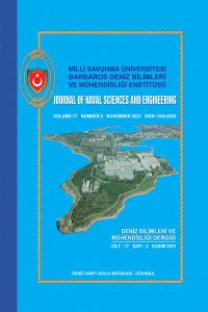GENEL BİR FIRKATEYNİN REFERANS ENERJİ SİSTEMİNİN GELİŞTİRİLMESİ
Gemi Enerji Sistemi Analizi, Referans Enerji Sistemi, Fırkateyn, Emisyon Kontrol Alanları, Sera Gazları
DEVELOPING THE REFERENCE ENERGY SYSTEM OF A GENERIC FRIGATE
Ship Energy System Analysis, Reference Energy System, Frigate, Emission Control Areas, Greenhouse Gases,
___
- Baldi F. (2016). “Modelling, analysis and optimization of ship energy systems,” Doctoral dissertation, Dept. of Shipping and Marine Technology, Chalmers University of Technology, Gothenburg, Sweden.
- Sulukan E., Özkan D., Sarı A., “Reference Energy System Analysis of a Generic Ship”, Journal of Clean Energy Technologies, Vol. 6, No. 5, 2018.
- Eyring V., Köhler H.W., Lauer A., Lemper B., Emissions from international shipping: 2. Impact of future technologies on scenarios until 2050, J. Geophys. Res. 110 (2005) D17306.
- Corbett J.J., Köhler H.W. (2003). Updated emissions from ocean shipping, J. Geophys. Res.108 (D20) 1–13.
- IMO, Third IMO GHG Study, Executive Summary and Final Report, 2014.
- Shell Report. (2019). https://www.shell.com/business-customers/marine/ imo-2020.html.
- DNV GL (2018). “Understanding IMO 2020”, Macquarie Research.
- Buhaug et al. (2009). Second IMO GHG Study 2009 Update of the 2000 GHG Study: Final Report Covering Phrases 1 and Phrases 2, IMO, London.
- Cames et al. (2015). Emission reduction targets for international aviation and shipping. [Online]. Available: http://www.europarl.europa.eu/ RegData/etudes/STUD/2015/569964/IPOL_STU(2015)569964_EN.pdf
- Heaps, C.G. (2016). Long-range Energy Alternatives Planning (LEAP) system. [Software version: 2018.1.20] Stockholm Environment Institute. Somerville, MA, USA. https://www.energycommunity.org
- Kydes, A.S., Kanudia A., Loulou R. (2004). “National Energy Modeling Systems”, Encyclopedia of Energy, Volume 4, 89-109.
- ISSN: 1304-2025
- Yayın Aralığı: 2
- Başlangıç: 2003
- Yayıncı: Milli Savunma Üniversitesi Deniz Harp Okulu Dekanlığı
GENEL BİR FIRKATEYNİN REFERANS ENERJİ SİSTEMİNİN GELİŞTİRİLMESİ
İbrahim Türksev BENLİ, Egemen SULUKAN, Ahmet Dursun ALKAN
Serkan KARAKAŞ, Mehmet KIRMIZI
ANALİTİK HİYERARŞİ SÜRECİ VE 0-1 HEDEF PROGRAMLAMA YÖNTEMİ İLE GEMİ PİS SU ARITMA ÜNİTESİ SEÇİMİ
SUÜSTÜ SAVAŞ GEMİLERİNİN BEKA KABİLİYETİNİN DEĞERLENDİRİLMESİ
Kadir ATASEVEN, Hüseyin YILMAZ
BU GEZEGENİNİ SEVENLER İÇİN YAPILAN SON ÇAĞRIDIR, GEL VE GEZEGENİNİ KURTAR: PROJE ÖNERİSİ
